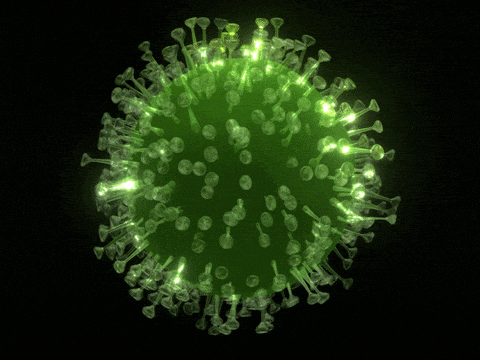
France: new Sars-CoV-2 variant B.1.640.2 with N501Y and E484K detected
Twelve SARS-CoV-2 positive patients living in southeastern France are infected with a variant with atypical mutations. The index case returned from travel in Cameroon.
Their analysis revealed 46 mutations and 37 deletions resulting in 30 amino acid substitutions and 12 deletions. Fourteen amino acid substitutions, including N501Y and E484K, and 9 deletions are located in the spike protein.
This genotype pattern led to create a new Pangolin lineage named B.1.640.2, which is a phylogenetic sister group to the old B.1.640 lineage renamed B.1.640.1. Both lineages differ by 25 nucleotide substitutions and 33 deletions. The mutation set and phylogenetic position of the genomes obtained here indicate based on our previous definition a new variant we named ‘IHU’.
Medrxiv preprint: Emergence in Southern France of a new SARS-CoV-2 variant of probably Cameroonian origin harbouring both substitutions N501Y and E484K in the spike protein
UPDATE 31/12/2021 – from the French Public Health Department
The B.1.640 variant is classified as a variant under investigation (VUM) by Public Health France (at 12/11/2021) as well as by WHO, ECDC and UKHSA. Since December 8, 2021, the B.1.640 lineage has been divided into two sublines: B.1.640.1 and B.1.640.2.
B.1.640.1 corresponds to the sequences of B.1.640 initially detected, and is majority. B.1.617.2* was detected within a cluster at the end of November 2021 in the Provence-Alpes-Côte region Azure.
B.1.640.2 is characterized by the presence of the E484K mutation (one of the targets of the current strategy screening), which is not present in B.1.640.1. The discrimination between these two sub-lineages is not still included in bioinformatic analysis tools. In this risk analysis, no difference is made between the two sublineages of B.1.640 and all cases are considered 20A / C variants B.1.640.
Public Health Document: Mise à jour de l’analyse de risque sur les variants émergents du SARS-CoV-2 du 01/12/2021 réalisée conjointementpar Santé publique France et le CNR des virus des infections respiratoires (PDF download in French)
*note: we’re pretty sure they mean B.1.640.2 here, not B.1.617.2
UPDATE – 1st January 2021 – from Github
In a similar vein to the recent split of B.1.1.529(Omicron) into two sister sublineages it appears B.1.640 may also have a similar issue with a major group constating of the vast majority of sequences and a small outgroup which appears related but has a very different set of mutations (EPI_ISL_7181977; EPI_ISL_7156959; EPI_ISL_7156955; EPI_ISL_6315910; EPI_ISL_5926666) and includes sequences from France and England, indicating some degree of spread.
Defining mutations (mutations not shared between both groups shown in bold):
Major lineage:
Spike – P9L, E96Q, Δ136-144, R190S*, I210T, R346S, N394S, Y449N, F490R, N501Y, D614G, P681H, T859N, D936H
Non-spike – NSP2 – P129L, E272G; NSP3 – L1301F, A1537S; NSP4 – S386F, R401H, T492I; NSP6 – V149A; NSP12 – P323L; T32I, Q57H; M – I82T; ORF8 – Q27*STOP; N- D22Y, T205I, E378Q; S2m deletion
Minor lineage:
Spike – P9L, E96Q, Δ136-144, R190S, D215H, R346S, N394S, Y449N, E484K, F490S, N501Y, D614G, P681H, T859N, D1139H
Non-spike – NSP2 – P129L; NSP4 – D459N; NSP6 – Δ106-108, T181I; NSP12 – P323L; NSP13 – V371A; NSP14 – P46S, V437F; ORF3a – T32I, Q57H; M – I82S; ORF8 – Q27*STOP; N – D22Y, T205I
Github report – Proposal to split B.1.640 into two sublineages
Un nouveau variant COVID-19 à été détecté à l'IHU Méditerranée Infection issu de patients de Forcalquier. Il a été baptisé variant IHU et déposé sur GISAID sous le nom de B.1.640.2. pic.twitter.com/Rh3klIxy0w
— IHU Méditerranée Infection (@IHU_Marseille) December 9, 2021
Lots of chat about B.1.640.2 in the last few days – just a few points to keep in mind:
– B.1.640.2 actually predates Omicron
– in all that time there are exactly… 20 sequences (compared to the >120k Omis in less time)
Def not one worth worrying about too much at the mo…— Tom Peacock (@PeacockFlu) January 3, 2022
🟢Though predates omicron, sequences have not grown rapidly
🟢 Mutation specific qPCR assays can screen and differentiate from Delta and Omicron
🔴We don't know whether the increasing cases in South France 🇫🇷 are associated with the new variant— Vinod Scaria (@vinodscaria) January 4, 2022
France: new coronavirus variant B.1.640 detected in Finistère, Brittany
France: new coronavirus variant B.1.640 detected in Finistère, Brittany
Image by Rudy and Peter Skitterians from Pixabay





